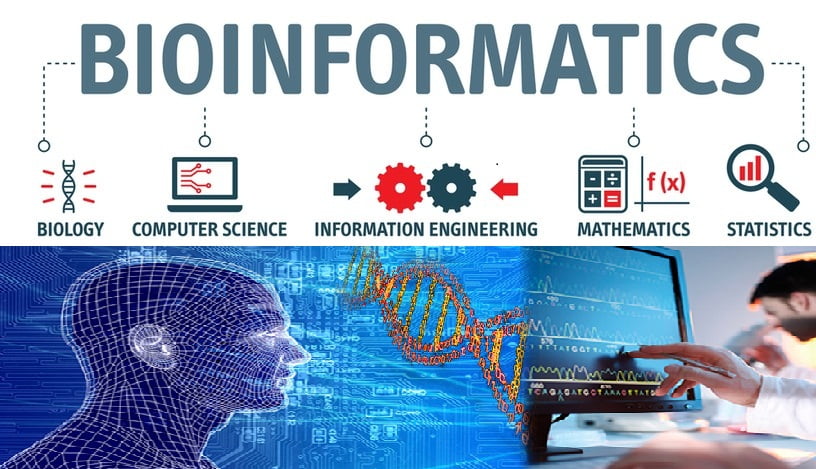Bioinformatics is an interdisciplinary field that develops methods and software tools for understanding biological data, in particular when the data sets are large and complex. As an interdisciplinary field of science, bioinformatics combines biology, computer science, information engineering, mathematics and statistics to analyze and interpret the biological data.
Bioinformatics includes biological studies that use computer programming as part of their methodology, as well as a specific analysis “pipelines” that are repeatedly used, particularly in the field of genomics. Common uses of bioinformatics include the identification of candidates genes and single nucleotide polymorphisms (SNPs). Often, such identification is made with the aim of better understanding the genetic basis of disease, unique adaptations, desirable properties (esp. in agricultural species), or differences between populations. In a less formal way, bioinformatics also tries to understand the organizational principles within nucleic acid and protein sequences, called proteomics.
Bioinformatics has become an important part of many areas of biology. In experimental molecular biology, bioinformatics techniques such as image and signal processing allow extraction of useful results from large amounts of raw data. In the field of genetics, it aids in sequencing and annotating genomes and their observed mutations. It plays a role in the text mining of biological literature and the development of biological and gene ontologies to organize and query biological data. It also plays a role in the analysis of gene and protein expression and regulation. Bioinformatics tools aid in comparing, analyzing and interpreting genetic and genomic data and more generally in the understanding of evolutionary aspects of molecular biology. At a more integrative level, it helps analyze and catalogue the biological pathways and networks that are an important part of systems biology. In structural biology, it aids in the simulation and modeling of DNA, RNA, proteins as well as biomolecular interactions.
Bioinformatics Goals
To study how normal cellular activities are altered in different disease states, the biological data must be combined to form a comprehensive picture of these activities. Therefore, the field of bioinformatics has evolved such that the most pressing task now involves the analysis and interpretation of various types of data. This also includes nucleotide and amino acid sequences, protein domains, and protein structures. The actual process of analyzing and interpreting data is referred to as computational biology. Important sub-disciplines within bioinformatics and computational biology include:
• Development and implementation of computer programs that enable efficient access to, management and use of, various types of information.
• Development of new algorithms (mathematical formulas) and statistical measures that assess relationships among members of large data sets. For example, there are methods to locate a gene within a sequence, to predict protein structure and/or function, and to cluster protein sequences into families of related sequences.
The primary goal of bioinformatics is to increase the understanding of biological processes. What sets it apart from other approaches, however, is its focus on developing and applying computationally intensive techniques to achieve this goal. Examples include: pattern recognition, data mining, machine learning algorithms, and visualization. Major research efforts in the field include sequence alignment, gene finding, genome assembly, drug design, drug discovery, protein structure alignment, protein structure prediction, prediction of gene expression and protein–protein interactions, genome-wide association studies, the modeling of evolution and cell division/mitosis.
Bioinformatics now entails the creation and advancement of databases, algorithms, computational and statistical techniques, and theory to solve formal and practical problems arising from the management and analysis of biological data.

Bioinformatics Tool & Analysis
Tools of a bioinformatics expert are computer software programs and the internet. The main activity is sequence analysis of DNA and proteins using various programs and databases available on the world wide web. Bioinformatics expert from clinicians to molecular biologists, with access to the internet and relevant websites can now freely discover the composition of biological molecules such as nucleic acids and proteins by using basic bioinformatics tools for retrieving, sorting out, analyzing, predicting, and storing DNA and protein sequence data.
The growth of bioinformatics has been a global venture, creating computer networks that have allowed easy access to biological data and enabled the development of software programs for effortless analysis. Multiple international projects aimed at providing gene and protein databases are available freely to the whole scientific community via the internet.
Useful bioinformatics websites (available freely on the internet)
| Bioinformatics tool | Bioinformatics Resources | Bioinformatics websites |
| National Center for Biotechnology Information (NCBI) | Maintains bioinformatics tools and databases | www.ncbi.nlm.nih.gov |
| National Center for Genome Resources (NCGR) | Scientists to bioinformatics solutions by collaborations, data, and software development | www.ncgr.org/ |
| Genbank | Stores and archives DNA sequences from both large scale genome projects and individual laboratories | www.ncbi.nlm.nih.gov/Genbank |
| Unigene | Gene sequence collection containing data on map location of genes in chromosomes | www.ncbi.nlm.nih.gov/UniGene |
| European Bioinformatic Institute (EBI) | Centre for research and services in bioinformatics; manages databases of biological data | www.ebi.ac.uk |
| Ensembl | Automatic annotation database on genomes | www.ensembl.org |
| BioInform | Global bioinformatics news service | www.bioinform.com |
| SWISS-PROT | Important protein database with sequence data from all organisms, which has a high level of annotation (includes function, structure, and variations) and is minimally redundant (few duplicate copies) | www.expasy.org/sprot/ |
| International Society for Computational Biology (ISCB) | Aims to advance scientific understanding of living systems through computation; has useful bioinformatics links | www.iscb.org/ |
Bioinformatics Applications in Life science & Health care
Bioinformatics has proven quite useful in medicine as the complete sequencing of the human genome has helped to unlock the genetic contribution for many diseases. Its applications include drug discovery, personalized medicine, preventative medicine and gene therapy.
Drug Discovery
The incorporation of bioinformatics into the drug discovery and development industry is often referred to as translational bioinformatics. Despite the medical advancements and discoveries that have revolutionized how diseases are diagnosed and treated over the past several decades, researchers estimate that only approximately 30% of all known diseases can be treated with currently available pharmacological agents. This gap in the availability of tested and approved therapies is further expanded by the fact that many biological targets have yet to be identified for many communicable and non-communicable diseases.
In addition to a lack of treatment options for known diseases, the emergence of novel viruses like the severe acute respiratory syndrome coronavirus 2 (SARS-CoV-2) further emphasizes the need to improve the rational drug design process.
Advancing the tools available for translational bioinformatics is one potential resolution to this growing problem. With its incorporation into almost every phase of the drug discovery process beginning with preclinical research on novel drugs and continuing throughout clinical trials and post-launch, translational bioinformatics can undoubtedly assist in the discovery of effective drugs for both communicable and non-communicable diseases.
Personalized Medicine
Medicine is experiencing a period of change: Extensive molecular biological data on the patient are increasingly included in diagnosis and treatment. This trend is based on the development of targeted drugs and accompanying diagnostics, which serve the purpose of providing advance evidence that the medication promises therapy success for the patient. According to this concept drugs are often given in combination. The sizes of patient groups for which a given therapy out of many possible alternatives can be expected to be successful are quite limited. The relationship between the molecular data pertaining to a patient and their disease phenotype are complex and cannot be determined manually. Thus, computer-based bioinformatics methods play a central role in interpreting the molecular data and as an instrument for providing recommendations for the practicing physician. Bioinformatics is an essential component in basic research, in the development of new concepts for diagnosis and therapy as well as in clinical practice, in which these concepts are applied to treating patients.
In the last decade, molecular science has made many advances to benefit medicine, including the Human Genome project, International HapMap project and genome wide association studies (GWASs) (International HapMap Consortium, 2005). Single nucleotide polymorphisms (SNPs) are now recognized as the main cause of human genetic variability and are already a valuable resource for mapping complex genetic traits. Thousands of DNA variants have been identified that are associated with diseases and traits. By combining these genetic associations with phenotypes and drug response, personalized medicine will tailor treatments to the patients’ specific genotype.
Preventative Medicine
Preventive medicine focuses on the health of individuals, communities and defined populations. It uses various research methods, including biostatistics, bioinformatics and epidemiology, to understand the patterns and the causes of health and disease, and to transform such information into programs designed to prevent disease, disability and death.
With the specific details of the genetic mechanisms of diseases being unraveled, the development of diagnostic tests to measure a persons susceptibility to different diseases may become a distinct reality. Preventative actions such as change of lifestyle or having treatment at the earliest possible stages when they are more likely to be successful, could result in huge advances in our struggle to conquer disease.
An example of preventive medicine is the screening of newborns immediately after birth for health disorders, such genetic diseases or metabolic disorders that are treatable but not clinically evident in the newborn period.
To develop such screening tests to identify the disease at an early stage, researchers use bioinformatics tools to analyze genomics, proteomics and metabolomics data for possible disease biomarkers.
Gene therapy
Gene therapy involves repair or replacement of mutated genes. Gene expression can also be altered in order to regulate the immune system. Gene therapy requires, characterization of defective gene, use of vector system for insertion of gene and recombination between defective and functional gene.
Gene therapy research has expanded from its original concept of replacing absent or defective DNA with functional DNA for transcription. Genetic material may be delivered via multiple vectors, including naked plasmid DNA, viruses and even cells with the goal of increasing gene expression; and the targeting of specific tissues or cell types is aimed at decreasing risks of systemic or side effects. As with the development of any drug, there is an amount of empiricism in the choice of gene target, route of administration, dosing and in particular the scaling-up from pre-clinical models to clinical trials. Systems Biology, whose arsenal includes high-throughput experimental and computational studies that account for the complexities of host-disease-therapy interactions, holds significant promise in aiding the development and optimization of gene therapies, including personalized therapies and the identification of biomarkers for success of these strategies.

